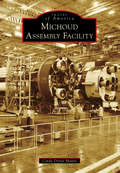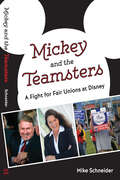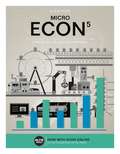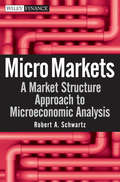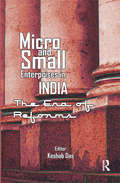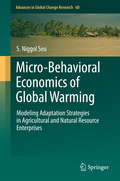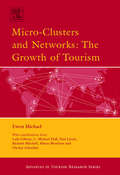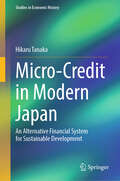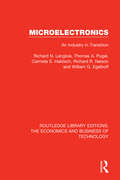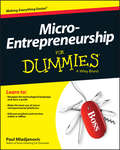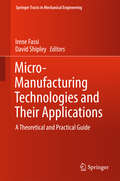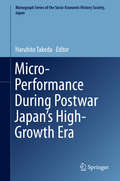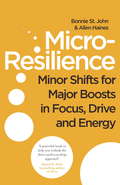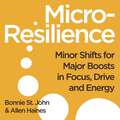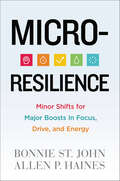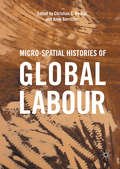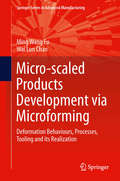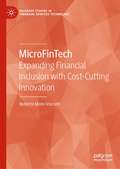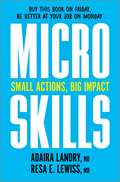- Table View
- List View
Michigan's C. Harold Wills: The Genius Behind the Model T and the Wills Sainte Claire Automobile
by Alan Naldrett Lynn Lyon Naldrett Terry ErnestOne of the unsung heroes of the auto world, C. Harold Wills designed the Model T when he worked as Henry Ford's right-hand man. Later, he founded his own company to produce the legendary Wills Sainte Claire. Every endeavor displayed his trademark inventiveness, from the development of the overhead cam engine to the toboggan run on the roof of his house. He used his money to create one of the first worker model cities at Marysville, Michigan. In this long-overdue biography, Alan and Lynn Lyon Naldrett preserve the legacy of an automotive icon.
Michoud Assembly Facility
by Cindy Donze MantoAfter an auspicious beginning as a royal land grant from French king Louis XV to a wealthy French citizen of New Orleans in 1763, the land Michoud Assembly Facility occupies remained in private ownership until 1940, when it was sold to the US government. Prior to World War II, the site was used to grow sugar, hunt muskrat, and build railroad and telephone lines. In 1941, the world's largest industrial site was built, covering 43 acres of unobstructed, low-humidity, air-cooled space under one roof to construct C-46 cargo planes. The Korean War required the assembly of Sherman and Patton tanks there, while the space race compelled the design and assembly of the colossal Saturn I, IB, and V rocket boosters for the Apollo program that reported directly to Dr. Wernher von Braun. The 1970s saw the fabrication of the enormous external tank for the Space Shuttle program. Today, Michoud Assembly Facility continues to support the US space program by building major components for the Orion Multi-Purpose Crew Vehicle (or MPCV).
Mickey and the Teamsters: A Fight for Fair Unions at Disney
by Mike SchneiderA behind-the-scenes look at the lives of Disney’s character performers and their struggles for union democracy Behind the costumes, life isn’t always magic and fairy dust for the people who play the iconic characters of Mickey Mouse, Goofy, and Cinderella at Walt Disney World. In a surprising tale of corruption alongside activism, Mickey and the Teamsters reveals the little-known story of Teamsters Local 385, the union that represents these performers. It spotlights Donna-Lynne Dalton, a former cast member who stood up for other Disney performers against deep-rooted problems in the union that was supposed to protect them.Journalist Mike Schneider, who covered the story as it unfolded, includes exclusive interviews with labor leaders and workers at the park, detailing how the union prevented its members from leaving, severely mismanaged union business, and promoted a culture of hostile leadership. Members of the Teamsters local felt that they no longer had a voice, fearing devastating consequences if they spoke up. But Dalton brought the issues to investigators in an act of whistleblowing that threatened her livelihood. In return, the local union fired Dalton and began harassing her and other union members who opposed its leaders. The story escalates as Schneider describes protests by the Disney performers and the interventions of James Hoffa, president of the International Brotherhood of Teamsters. Mickey and the Teamsters offers a behind-the-scenes look at some of the hidden struggles that surround Disney World, which employs the largest single-site workforce in the United States. Through the efforts of Dalton and others to reform their union and improve the lives of employees at the workplace they loved, Schneider shows the importance of individual and collective action to hold unions accountable and preserve their potential to do good.
Micro Devices Division
by Christopher D. Ittner Robin CooperThe company has excess capacity. The case explores the various issues surrounding accounting for the cost of capacity. Several definitions of capacity can be discussed and accounted for.
Micro Econ (New, Engaging Titles From 4ltr Press Series)
by William A. McEachern4LTR Press solutions give students the option to choose the format that best suits their learning preferences. This option is perfect for those students who focus on the textbook as their main course resource.
Micro Insurance Agency: Helping the Poor Manage Risk
by Michael Chu Jean Steege HazellThe notable success of insurance products for low-income clients of its microfinance network leads Opportunity International to launch the first global specialized microinsurance company, the Micro Insurance Agency (MIA). Building on the experience in 10 countries across Africa, Asia, and Latin America of developing products appropriate to the sector and acceptable to risk carriers, and minimizing distribution and administration costs by going through Opportunity International (OI) partner microfinance institutions (MFIs), MIA must now define the strategy for its future growth. Facing both the need to achieve scale and profitability as quickly as possible, and increasing competition from international and local providers with few barriers to entry, MIA must grapple with a series of strategic choices: geographic expansion, continued product innovation, serving MFIs outside of the OI network, and new distribution mechanisms to reach market segments beyond MFIs. Wholly owned by faith-based nonprofit OI, MIA must also factor in OI's desired mission impact with commercial viability. Illustrates the challenges and tradeoffs inherent in pioneering efforts at the edge of microfinance, the emerging industry to serve the financial needs of low-income sectors in the developing world.
Micro Markets
by Robert A. SchwartzA timely guide that bridges the gap between microeconomic theory and practice through real-world application in the marketplaceUnderstanding how microeconomics affects the marketplace is essential for any investment professional, however most books simply address microeconomics in its pure theory-based form. Micro Markets helps bridge the gap between theory and practice by defining microeconomics in terms of real-world, market applications.This timely guide elucidates basic microeconomic concepts with an emphasis on applicability. It establishes a common application for all of the basic economic concepts that are reviewed, and provides in-depth insights into an industry that is of major economic importance in aggregate, and to most individuals.Utilizes equity market realities to underscore the relevance of economic theoryEach chapter includes informative practice problems and power pointsA companion Workbook, with practice problems and solutions, is also availableBy taking microeconomic theory and making it applicable to today's marketplace, Micro Markets builds a much-needed bridge between theory and practice.
Micro Markets Workbook
by Robert A. Schwartz Michael G. Carew Tatiana MaksimenkoA companion Workbook to the text Micro Markets Understanding how microeconomics affects the marketplace is essential for any investment professional, however most books simply address microeconomics in its pure theory-based form. Micro Markets helped bridge the gap between theory and practice by defining microeconomics in terms of real-world, market applications. Now, the Micro Markets Workbook offers you a chance to review the information found in the actual book and solidify your understanding of this discipline. In this study guide, microeconomic concepts are fully reviewed, along with how all of its relevant theory is applicable to today's markets. Helps you learn to perform dynamic microeconomic analysis in practice Tests your knowledge of the information addressed in Micro Markets, before you put it to work in real world situations Provides solutions to each chapter of the main book's practice problems If you want to gain a firm understanding of the information outlined in Micro Markets, the lessons within this Workbook can help you achieve this goal.
Micro and Small Enterprises in India: The Era of Reforms
by Keshab DasThis book presents a set of analytical and deeply policy-oriented articles on the dynamics of growth and performance of micro and small enterprises in India during the period of reforms. It provides fairly detailed analyses of policy changes for the micro and small enterprises secotr as well as empirical analyses of performance and efficiency of the unorganised manufacturing sector. it examines a range of emerging and persistent complex issues facing this crucial sector including credit, exports, trade regulations, capacity building, subcontracting, clustering, entrepreneurship and rural industrialisation. Focusing on the constraints facing this sector even during the economic reforms, most of the articles analyse how and why special attention, particularly by the state, needs to be paid towards enhancing firm competitiveness. Broad-basing the benefits of policy interventions to the overwhelmingly present yet left out micro enterprises, including rural areas, forms an important concern. This volume attempts to critically examine critical areas of intervention that could open up possibilities of developing a strong micro and small enterprises sector in India.
Micro-Behavioral Economics of Global Warming
by S. Niggol SeoThis book presents a foundation for studying the micro-behavioral economics of global warming. The author develops an empirical model, named the Geographically-scaled Micro econometric model of Adapting Portfolios (G-MAP) in response to climatic changes and risks. The G-MAP model is applied to observed decisions of agricultural and natural resource enterprises in Sub-Saharan Africa and South America. The author describes the five applications of the model: the G-MAP animal species, the G-MAP agricultural systems, the G-MAP natural resource enterprises, the G-MAP climate risk, and the G-MAP public adaptations. The micro-behavioral economics of global warming and the G-MAP models are evaluated against the three alternative modeling traditions: The first is the Agro-Economic Models (AEM) based on crop simulations of selected crops under elevated CO2 conditions; The second is a family of econometric studies of grain yield changes caused by yearly weather fluctuations; The third is the Agro-Ecological Zone (AEZ) method hinged crucially on the AEZ classifications of ecosystems. The author offers a refreshing look at the traditional economics of global warming, unraveling a broad array of adaptation strategies adopted by managers of agricultural and natural resource enterprises in Sub-Saharan Africa and South America. The book demonstrates that the micro-behavioral economics dynamically integrates multiple disciplines in a cohesive way - including economics, psychology, climate science, ecosystem studies, agronomy and animal science - into the decision-making framework of an individual agent. The G-MAP models provide a guide map of adaptation strategies for the humanity's enduring journey of battling global climatic changes in this century and beyond.
Micro-Clusters and Networks (Routledge Advances In Tourism Ser.)
by Ewen MichaelThis book introduces a new approach to the analysis and management of growth in small tourism markets for regional and rural locations. It recognizes from the outset that the vast bulk of the tourism industry’s product is delivered by small business enterprises and that many of these are located outside of metropolitan areas. Its central premise is that a myriad of small-scale clusters can provide an effective means to establish a local competitive advantage in tourism activities based on the resources of existing communities. The book brings together contemporary views of the potential of clustering theory to promote development in micro-markets, within the paradigm of competition, to create a new framework for regional development that might serve to enhance the growth of small-scale tourism destinations.Microclusters and Networks provides a theoretical explanation of how and why micro-clusters come about, with chapters by specialist authors to illustrate examples of their practice in the real world; but it goes further to demonstrate not only why they work but also how community members interact to form successful clusters. The incorporation of networking theory provides the means to explain the role of local community interaction in delivering successful social outcomes. The analysis that is provided clearly has applications for many industries beyond the development of rural and regional tourism destinations.
Micro-Credit in Modern Japan: An Alternative Financial System for Sustainable Development (Studies in Economic History)
by Hikaru TanakaJapanese society believes they enjoy socio-economic equality. While industrialization tends to make gap between rich and poor, most of Japanese are proud of themselves as being middle class in the first Asian industrialized country. In fact, post WW2 Japanese economic miracle made Japan rich and equalized. High personal saving ratio supported the economic development in those days as if it’s a proof of Rostow’s take-off model. Japanese saving rate had jumped high level around the beginning of 20th century, which was the time of their industrialization taking place. This book shows the savings was not only rich’s accumulation of wealth but ordinary citizen’s daily spares. The spare money helped whole nation’s economic development, especially supported relatively small farmers and self-employed workers. The personal small savings became huge funds for the basis of modern Japanese micro-credit and emergency bailout loan. Postal Savings Bank and nationwide cooperatives played the role in managing. This financial network was independent from ordinary financial system composed of private banks and securities market, and complement its function. The personal small savings funds in Japanese economy saved its society from various type of calamity and supported economic equalization as alternative financial system which acted as Not-for-Profit enterprises.
Micro-Electronics: An Industry in Transition (Routledge Library Editions: The Economics and Business of Technology #27)
by Thomas Pugel Richard Langlois Carmela S. Haklisch Richard R Nelson William EgelhoffOriginally published in 1988 this book was the culmination of 7 years of research in micro-electronics by the Center for Science and Technology Policy in New York. It includes original comparative study of corporate strategy in American, Japanese, and European firms, as well as an account of the evolution of technical alliances. It provides a detailed examination of the global micro-electronics industry in all its aspects - technological, economic, strategic and institutional and goes beyond organizing and presenting the facts to offer new perspectives, analyses and opinions.
Micro-Entrepreneurship For Dummies
by Paul MladjenovicTired of the 9-to-5 grind and want a way to earn or to supplement your income? Easy.The media has named the growing trend toward micro-entrepreneurship "the Rise of the Creative Class," "the Gig Life," or "the freelance economy." All of those refer to the nearly 4 million workers who were self-employed this past year, and millions of others who currently supplement their income with freelance work. While the trend has been spotted before, there's one stark difference between micro-entrepreneurs today and the "Free Agent Nation" citizens of the late '90s: technology. Micro-Entrepreneurship For Dummies shows you how to navigate this confusing technological landscape in order to make a contributable profit.Micro-Entrepreneurship For Dummies aids you in making the best use of micro-entrepreneurial platforms, with helpful advice that includes information on signing up for and selling products on websites such as Airbnb, Craigslist, Taskrabbit, Uber, and Etsy.Micro-enterprise, using online platforms to sell products or services,??is a proven way to earn extra money and supplement household incomeIn today's struggling economy, the importance of self-run businesses and small enterprise is growing as more people take lower-paying jobs and need a little extra spending moneyShows you how to sign up for and sell products onlineMicro-Entrepreneurship For Dummies appeals to anyone looking to earn or supplement their income from home.
Micro-Manufacturing Technologies and Their Applications
by David Shipley Irene FassiThis book provides in-depth theoretical and practical information on recent advances in micro-manufacturing technologies and processes, covering such topics as micro-injection moulding, micro-cutting, micro-EDM, micro-assembly, micro-additive manufacturing, moulded interconnected devices, and microscale metrology. It is designed to provide complementary material for the related e-learning platform on micro-manufacturing developed within the framework of the Leonardo da Vinci project 2013-3748/542424: MIMAN-T: Micro-Manufacturing Training System for SMEs. The book is mainly addressed to technicians and prospective professionals in the sector and will serve as an easily usable tool to facilitate the translation of micro-manufacturing technologies into tangible industrial benefits. Numerous examples are included to assist readers in learning and implementing the described technologies. In addition, an individual chapter is devoted to technological foresight, addressing market analysis and business models for micro-manufacturers.
Micro-Performance During Postwar Japan's High-Growth Era
by Haruhito TakedaThe aim of this book is to analyze Japan's high-growth economy, in particular to clarify the kinds of changes in people's lives that were generated by high growth. The present volume focuses not on the macro-economic mechanisms that expanded the scale of the economy, but on the micro-economic changes that were effected in everyday life. The emergence of a mass consumption society as a result of economic growth suggests that people's lifestyles and consumer behavior changed in various ways. The first chapter focuses on the apparel industry's expanding market as it corresponded to changes in consumer behavior. Even as consumer life became more comfortable and abundant, consumers were becoming uneasy about the environmental deterioration associated with high growth. The second chapter examines how the Japanese government addressed emissions regulations while drawing on the lessons of America's experience with the same issue. The change in industrial structure brought about by economic growth inevitably resulted in the decline of other industries. Chief among these was the coal-mining industry, which, with the onset of a full-scale energy revolution, lost its role as energy supplier owing to the import of cheap crude oil. The third chapter discusses the government's industrial policies as they addressed the coal industry's adjustment in the high-growth era, concluding that they reduced such problems as stagnation, unemployment, and local industrial decline. The adjustments in employment practices contributed positively to the gradual shift of labor from declining industries to growth industries. The fourth chapter investigates changes in labor management in the steel industry, which was one of the high-growth era's leading industries. This publication will serve as a valuable resource for those who are interested not only in the post-war history in Japan but also in high growth economies in recent East Asia.
Micro-Resilience: Minor Shifts for Major Boosts in Focus, Drive and Energy
by Bonnie St. John Allen P. Haines'Micro-Resilience is a powerful book that will help you rethink the drive-until-you-drop approach to work. By re-framing your thinking, you can learn to learn bounce back from setbacks and create a life of power and meaning' Daniel Pink, author of Drive and To Sell is HumanAs leadership consultants and executive trainers, Bonnie St. John and Allen Haines have heard the same complaints from clients for years; periodic burnout, lack of focus and low energy. So they dug into the latest research on neuroscience, psychology and physiology looking for big answers. Instead they found small answers; proof that small adjustments in daily routines, including thought patterns, food and drink, rest and movement can fight the forces that sap our energy and store focus and drive. They call these amazing efficient restorative techniques 'micro-resilience.'Thousands of men and women from all walks of life have already found effortless ways to incorporate these little changes into the busiest of schedules. Dozens of entertaining anecdotes from real people using micro-resilience demonstrate that when our brains fire faster, our energy increases and we can cope with almost any surprise, pressure or crisis, no matter how big or small.
Micro-Resilience: Minor Shifts for Major Boosts in Focus, Drive and Energy
by Bonnie St. John Allen P. Haines'Micro-Resilience is a powerful book that will help you rethink the drive-until-you-drop approach to work. By re-framing your thinking, you can learn to learn bounce back from setbacks and create a life of power and meaning' Daniel Pink, author of Drive and To Sell is HumanAs leadership consultants and executive trainers, Bonnie St. John and Allen Haines have heard the same complaints from clients for years; periodic burnout, lack of focus and low energy. So they dug into the latest research on neuroscience, psychology and physiology looking for big answers. Instead they found small answers; proof that small adjustments in daily routines, including thought patterns, food and drink, rest and movement can fight the forces that sap our energy and store focus and drive. They call these amazing efficient restorative techniques 'micro-resilience.'Thousands of men and women from all walks of life have already found effortless ways to incorporate these little changes into the busiest of schedules. Dozens of entertaining anecdotes from real people using micro-resilience demonstrate that when our brains fire faster, our energy increases and we can cope with almost any surprise, pressure or crisis, no matter how big or small.
Micro-Resilience: Minor Shifts for Major Boosts in Focus, Drive, and Energy
by Bonnie St. JohnLearn powerful, science-based techniques to boost focus, drive and energy hour-by-hour throughout the day -- every day. As leadership consultants and executive trainers, Bonnie St. John and Allen P. Haines have heard the same complaints from clients for years; periodic burnout, lack of focus and low energy. So they dug into the latest research on neuroscience, psychology and physiology looking for big answers. Instead they found small answers; proof that small adjustments in daily routines, including thought patterns, food and drink, rest and movement can fight the forces that sap our energy and store focus and drive. They call these amazing efficient restorative techniques "micro-resilience." Thousands of men and women from all walks of life have already found effortless ways to incorporate these little changes into the busiest of schedules. Dozens of entertaining anecdotes from real people using micro-resilience demonstrate that when our brains fire faster, our energy increases and we can cope with almost any surprise, pressure or crisis.
Micro-Spatial Histories of Global Labour
by Anne Gerritsen Christian G. De VitoThis volume suggests a new way of doing global history. Instead of offering a sweeping and generalizing overview of the past, we propose a 'micro-spatial' approach, combining micro-history with the concept of space. A focus on primary sources and awareness of the historical discontinuities and unevennesses characterizes the global history that emerges here. We use labour as our lens in this volume. The resulting micro-spatial history of labour addresses the management and recruitment of labour, its voluntary and coerced spatial mobility, its political perception and representation and the workers' own agency and social networks. The individual chapters are written by contributors whose expertise covers the late medieval Eastern Mediterranean to present-day Sierra Leone, through early modern China and Italy, eighteenth-century Cuba and the Malvinas/Falklands, the journeys of a missionary between India and Brazil and those of Christian captives across the Ottoman empire and Spain. The result is a highly readable volume that addresses key theoretical and methodological questions in historiography.
Micro-scaled Products Development via Microforming
by Ming Wang Fu Wai Lun Chan'Micro-scaled Products Development via Microforming' presents state-of-the-art research on microforming processes, and focuses on the development of micro-scaled metallic parts via microforming processes. Microforming refers to the fabrication of microparts via micro-scaled plastic deformation and presents a promising micromanufacturing process. When compared to other micromanufacturing processes, microforming offers advantages such as high productivity and good mechanical properties of the deformed microparts. This book provides extensive and informative illustrations, tables and photos in order to convey this information clearly and directly to readers. Although the knowledge of macroforming processes is abundant and widely used in industry, microparts cannot be developed by leveraging existing knowledge of macroforming because the size effect presents a barrier to this knowledge transfer. Therefore systematic knowledge of microforming needs to be developed. In tandem with product miniaturization, the demand on microparts has been increased for their wide applications in many industries, including automotive, bio-medical, aerospace and consumer electronics industries. Micromanufacturing technologies have thus become more and more important. This book is intended for postgraduates, manufacturing engineers and professionals working in the areas of manufacturing and materials processing.
MicroEconomics: A Basic Perspective
by Roger MackFor many of you, economics is among the most feared and most challenging courses that you will enroll in during your college experience. Despite this, economics is also a subject matter that will stay with you, be actively used and may well have the most impact throughout your life. Economics involves a way of thinking about choices and outcomes. In a very real sense, both the teaching and the learning of economics is "work in progress." Your choices and the choices of others around you, the resulting outcomes, and the opportunities, both chosen and given up, greatly determine much of the quality of your life.
MicroFinTech: Expanding Financial Inclusion with Cost-Cutting Innovation (Palgrave Studies in Financial Services Technology)
by Roberto Moro-ViscontiMicrofinance is a renowned albeit controversial solution for giving financial access to the unbanked, even if micro-transactions increase costs, limiting outreach potential. The economic and financial sustainability of Microfinance Institutions (MFIs) is a prerequisite for widening a potentially unlimited client base. Automation decreases costs, expanding the outreach potential, and improving transparency and efficiency. Technological solutions range from branchless mobile banking to geo-localization of customers, digital/social networking for group lending, blockchain validation, big data, and artificial intelligence, up to “MicroFinTech” - FinTech applications adapted to microfinance. Of interest to both scholars, students, and professors of financial technology and microfinance, this book examines these trendy solutions comprehensively, going beyond the existing literature and showing potential applications to the traditional sustainability versus outreach trade-off.
MicroFridge: The Concept
by John DeightonRobert Bennett, who has a Master's degree in engineering, wants to exploit his idea to combine a refrigerator, freezer, and 500-watt microwave into an 87-pound, 4-foot-high appliance to sell to college students. Bennett must decide which markets to serve, which competitors he must contend with, with whom to collaborate, and what core capabilities to build.
MicroSkills: Small Actions, Big Impact
by Adaira Landry M.D. Resa E. Lewiss M.D.The promise of this book is simple: if you buy this book on Friday, you will be better at your job by Monday.MicroSkills is built on one core, easy-to-learn principle: every big goal, complicated task, healthy habit, and, yes, even what we think of as character traits, can be broken down into small, learnable, skills that can be practiced, and incorporated real-time. We call these: MicroSkills.As award winning physicians, educators, and mentors we hear the gamut of challenges with navigating the workplace. And when we learn a lesson we often wish we had learned it earlier. MicroSkills is packed with the privileged information that you want delivered to you as efficiently as possible.In MicroSkills you will learn How to build your career without breaking yourself How to manage your task list to get work done How to build and maintain your professional reputation How to become a subject matter expert How to grow and nurture your network How to become a better communicator and so much more...MicroSkills is the gift we wish we had received early in our careers.

